02 Apr 2025 17 MIN READ
The Role of AI in Supply Chain Planning: An overview of key methodologies – S&OP, S&OE, IBP, and DDMRP – combined with AI for supply chain optimization
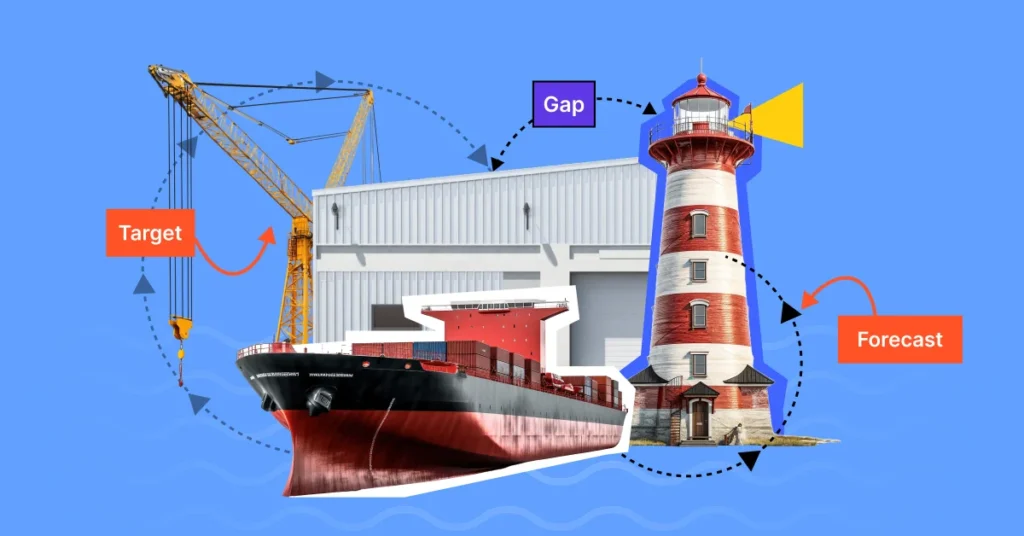
Supply chain processes in business are like data flow in a large IT infrastructure: when information is transmitted smoothly, the system operates efficiently, ensuring stability and productivity. However, if a single node fails, delays arise, errors accumulate, and overall system performance declines. We invite you to explore how various methodologies – S&OP, S&OE, IBP, and DDMRP – combined with powerful AI-driven forecasting algorithms not only help predict future changes but also enable businesses to adapt to new realities, optimize the supply chain, and ensure the flexibility needed to stay competitive in dynamic market conditions.
How the Use of AI in Supply Chain Management Helps Businesses Respond Quickly to Market Changes and Make Strategic Decisions
In today’s reality, the market generates an increasing volume of unstructured data – from sudden shifts in demand to logistical constraints – creating numerous challenges in Supply Chain Management.
Key Challenges in Supply Chain Identified by Experts:
- Market Volatility – Economic crises, pandemics, and war create significant fluctuations in demand. Supply chains need support to manage these disruptions effectively. When demand changes instantly and unpredictably, companies must have flexible and adaptive systems. AI for Supply Chain Management becomes a key tool for timely adjustments in supply, production, and logistics planning, helping to minimize losses and optimize resources.
- Forecasting Issues – Traditional manual demand forecasting methods, based on historical data and linear models, fail to deliver accurate results in dynamic conditions. Demand for products and services shifts faster than ever before, often unpredictably. It is no longer enough to simply observe and react afterwards; businesses need a proactive approach that includes scenario planning for various possible developments. Companies must learn to act based on demand forecasts rather than merely responding to unexpected changes.
- Logistics Flexibility – Overloaded border checkpoints, delays, container shortages, labor shortages (including a lack of drivers and warehouse workers), and rising logistics costs all pose serious obstacles to efficient supply chain operations. These challenges not only increase delivery times but also raise costs, affecting overall company profitability. AI in logistics and supply chain management helps overcome these hurdles.
- Lack of Transparency – One of the major issues in modern supply chains is the lack of transparency in the systems used to manage supply operations. The more complex and branched these systems become, the harder it is to maintain a clear view of the entire supply chain. Difficulties in tracking each stage of the supply process lead to risks such as delays, errors, and even losses. To ensure smooth operations, businesses must implement more transparent, integrated systems that provide real-time monitoring and control at every stage of the supply chain.
A powerful solution to overcome these challenges is digitalization and the adoption of modern technologies powered by AI algorithms. These innovations open new opportunities for businesses, a good example being SMART Demand Forecast which helps companies stay ahead in an unpredictable market.
Business Benefits of Digitalization
- Automation of Key Processes – Demand forecasting involves processing vast amounts of Big Data. A crucial methodology in this context is Sales Execution, the process of implementing a sales strategy. It relies on real-time decision-making based on up-to-date data. However, for this methodology to be effective, businesses need modern systems with high computational power, as analyzing and processing large datasets in real time is impossible without them.
- Information Aggregation – Digitalization significantly enhances this area as well. For example, AI and IoT in Supply Chain unlock new possibilities for logistics management. IoT (Internet of Things) technology enables real-time tracking of cargo locations, while AI helps analyze this data, predict delays, and optimize routes. This allows businesses to monitor shipments, identify causes of delays (such as customs clearance issues), and respond promptly to any disruptions or route changes. Information aggregation improves supply chain control, enhances planning, and enables more informed decision-making.
- Big Data Analytics and Demand Forecasting in Supply Chains – Digitalization provides extensive capabilities for prediction, forecasting, and data utilization. This applies not only to internal Big Data collected and used by businesses but also to external data sources such as social media activity, website clicks, and other digital interactions. Modern systems can efficiently gather and process this information in real time, providing valuable insights for businesses.
- Cloud Solutions – Enable access to synchronized data from anywhere in the world. In the Supply Chain context, cloud-based solutions empower internationally operating companies to effectively manage logistics and supply processes through data synchronization, real-time monitoring, and remote management. Cross-functional teams and business partners can collaborate on data, negotiate deals, adjust orders, or plan delivery routes – regardless of their physical location, whether in different cities or countries.
The Benefits of Using Supply Chain AI
Today, AI applications in Supply Chain can be numerous. The use of artificial intelligence in Supply Chain Management can significantly enhance processes by integrating into key company methodologies and optimizing numerous business processes.
Let’s explore the main benefits of the use of AI in Supply Chain optimization compared to traditional approaches:
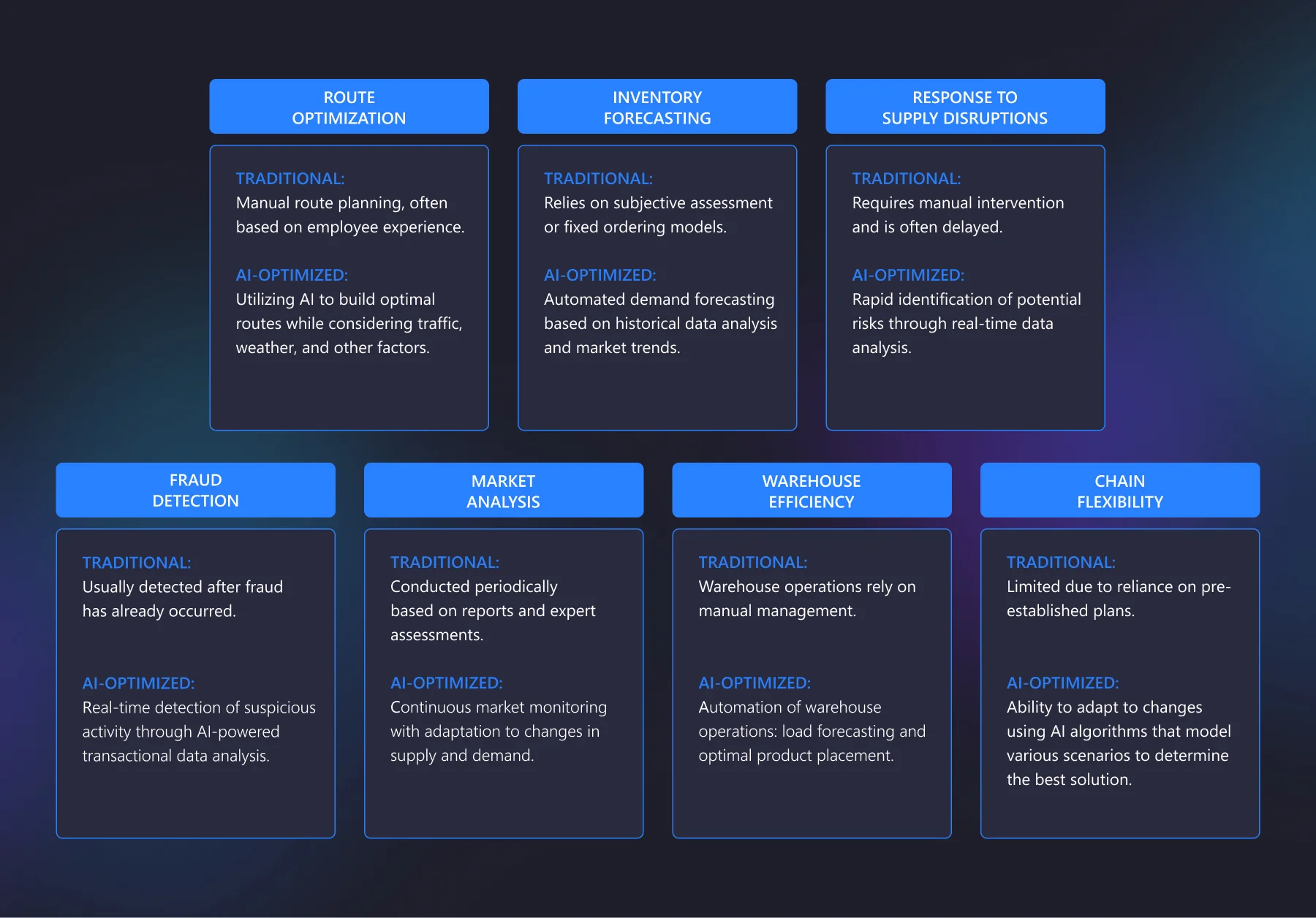
As we can see, an AI-optimized approach in the supply chain increases business process efficiency and flexibility, with demand forecasting automation being a crucial component. For instance, the SMART Demand Forecast solution, powered by AI algorithms, analyzes historical data and market trends to provide accurate demand forecasts. This solution reduces supply chain disruption risks and serves as an effective tool for optimizing processes at all stages of the supply chain. The system enables businesses not only to react to current challenges but also to act proactively. Moreover, SMART Demand Forecast seamlessly integrates into a company’s chosen strategic methodologies, allowing demand forecasting to be effortlessly combined with other business processes, such as inventory management, production planning, and logistics.
Comparison of Methodologies for Supply Chain Optimization: S&OP, S&OE, IBP, DDMRP, and Others. When and Which Ones Should Be Used to Maximize Supply Chain Efficiency?
Methodologies play a vital role in adopting AI for Supply Chain optimization, providing clearly defined approaches, rules, and strategies that help organize and optimize business processes. If chaotic processes are automated using AI solutions without clear rules and a well-thought-out approach, the risk of creating an automated mess is high. To avoid this, let’s break down the key methodologies that will not only automate business processes but also structure them for maximum benefit.
Overview of the Sales & Operations Planning Methodology
Sales & Operations Planning (S&OP) is a cyclical methodology that helps companies align demand, resources, financial planning, and product management. The S&OP process aims to balance what the business can supply (produce) with what the market needs. It includes several key stages, such as product review, demand review, supply review, financial review, and management review. Each stage is critical for ensuring continuous adaptation to market changes:
- Product Review involves analyzing the product portfolio, new product plans, and competitors.
- Demand Review includes pricing strategy formation, promotional activity planning, and demand forecasting.
- Supply Review focuses on resource analysis, supply scenario development, and inventory optimization.
- Financial Review is an essential stage where demand and supply plans are aligned, and financial forecasts are developed.
- Management Review concludes the process, involving a review of key performance indicators and strategy adjustments.
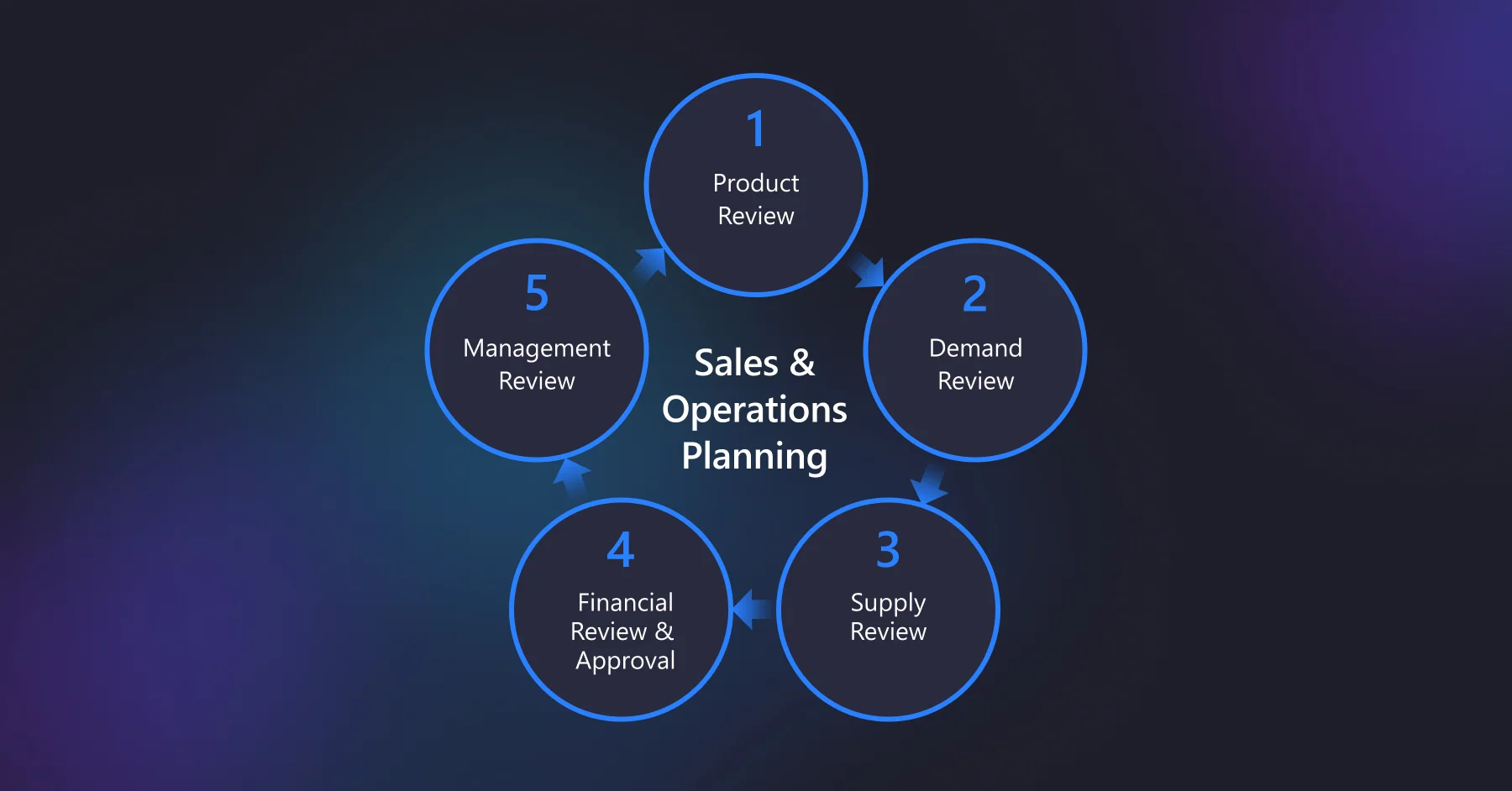
Integrating AI into S&OP significantly enhances the methodology by automating demand forecasting, financial analysis, and risk management, as well as optimizing processes at all stages. In the context of Supply Chain optimization, AI improves demand forecasting accuracy through machine learning algorithms, seasonal trend analysis, and real-time forecast adjustments. AI also enables automated risk management and cost optimization, enhancing the speed and accuracy of decision-making in supply and production planning. With AI, the S&OP methodology becomes more flexible, allowing companies to adapt to changing conditions while maintaining a competitive advantage.
Overview of the Sales & Operations Execution Methodology
Moving beyond strategic planning (S&OP), the next logical step is the Sales & Operations Execution (S&OE) methodology – which focuses on real-time execution and adaptation of plans. This methodology emphasizes operational management and responsiveness to current constraints, challenges, risks, and anomalies that arise in business processes. The key stages of S&OE include a cyclical operational review, where actual demand and supply data are analyzed daily or weekly, deviations from the plan are identified, and real-time adjustments are made. A critical component is updating operational plans, which involves modifying production schedules, optimizing inventory based on new forecasts, and coordinating with key teams (logistics, production, sales).
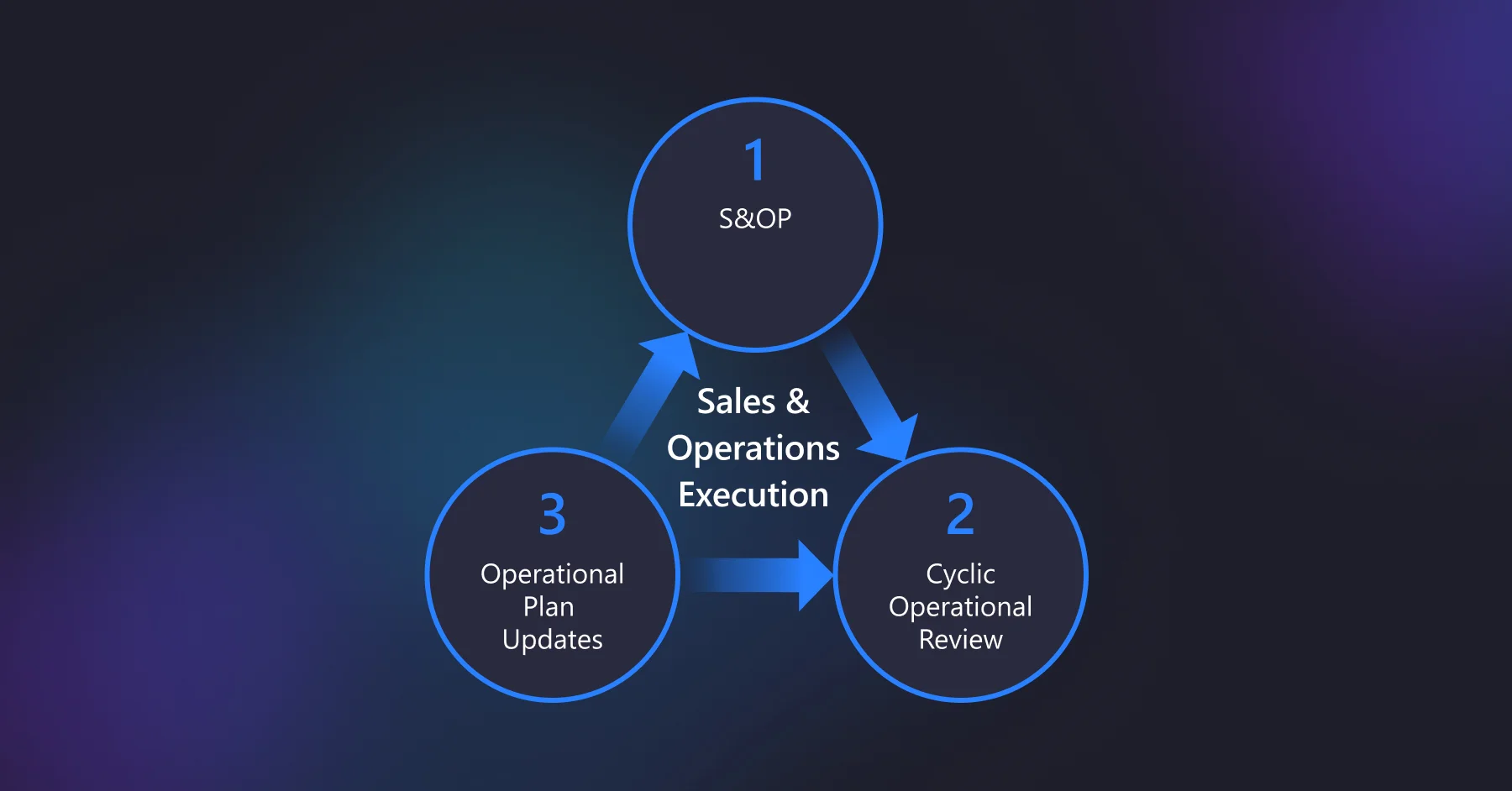
The integration of AI into S&OE significantly expands the capabilities of this methodology by automating processes and decision-making. AI can assist with dynamic adjustments to operational plans, analyze data, and automatically update production schedules, adapting the supply chain and resources accordingly. The use of AI in Supply Chain management and logistics also optimizes inventory management, automating resource balancing across warehouses and production centers. Additionally, AI can monitor execution efficiency, identifying bottlenecks and operational delays, while providing recommendations for improving productivity and reducing costs. AI collects and analyzes data in real time, detects deviations from the plan, and alerts teams to potential risks, helping businesses respond quickly to market changes.
Overview of the IBP Methodology
The IBP (Integrated Business Planning) methodology is a powerful tool that aligns strategic planning with operational execution, ensuring a balance between business strategy and actual company processes. It integrates strategic planning, budgeting, accounting, auditing, and reporting with Sales & Operations Planning (S&OP), providing transparency in business process management. IBP enables businesses to see the interconnections between different departments. For instance, an increase in product demand may require an increase in production, which in turn affects the supply chain and HR resources.
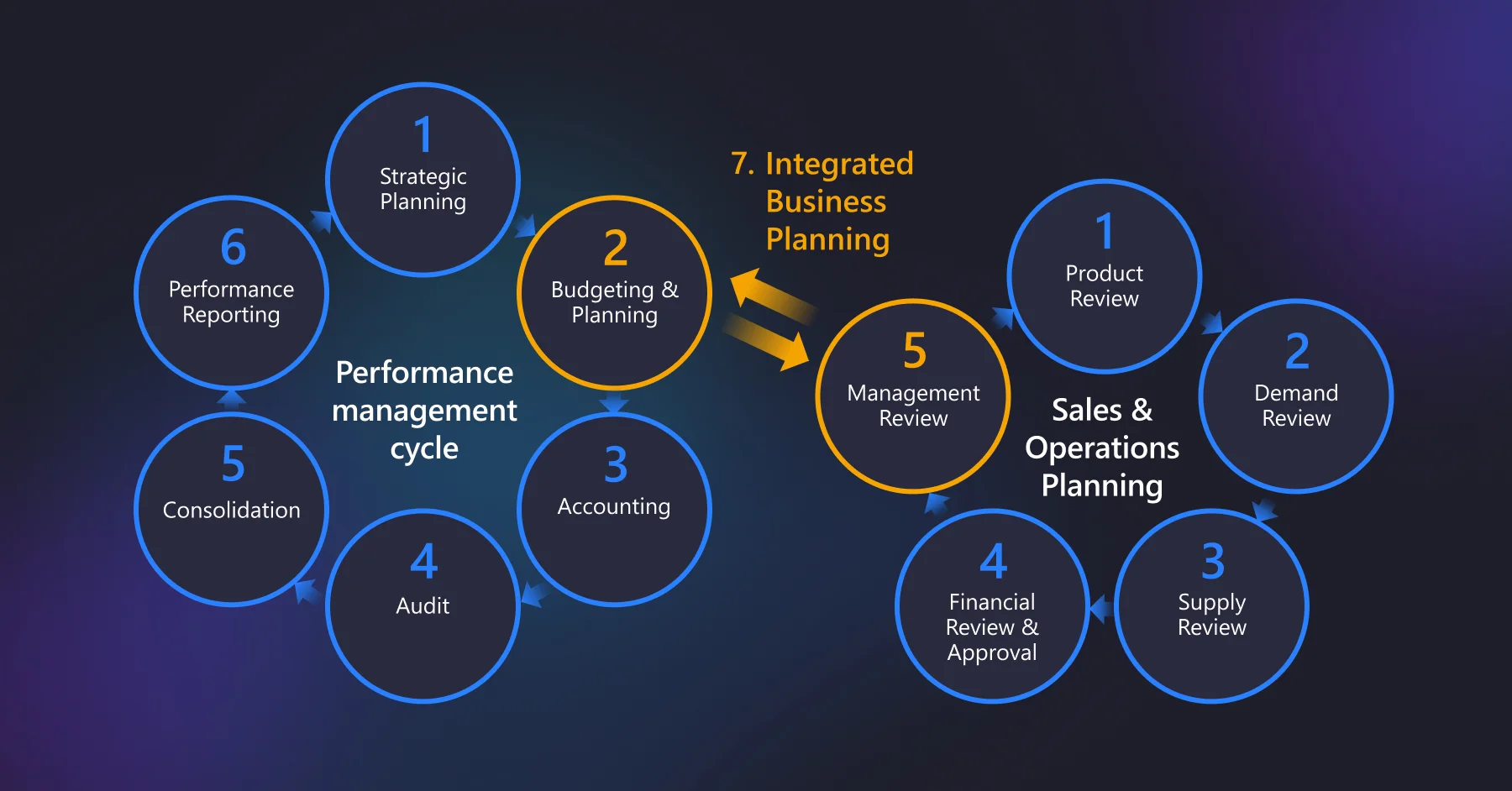
Implementing AI within IBP offers significant benefits, including market condition forecasting, automated financial control, budget optimization, and real-time data management – all of which greatly enhance decision-making speed and overall business efficiency.
Overview of the DRP Methodology
DRP (Distribution Requirements Planning) is a methodology that helps optimize the supply chain and allocate resources between warehouses, distributors, and end sales points. It includes several key stages: demand analysis to identify seasonality and trends, financial analysis of costs related to transportation, warehouse maintenance, and inventory management, as well as coordination of production processes to prevent overstocking or shortages. It also involves identifying constraints such as transportation routes or delivery timelines, which are crucial for risk reduction and ensuring timely distribution. The methodology also encompasses distribution planning, which includes prioritizing regions and customers and continuously monitoring plan execution.
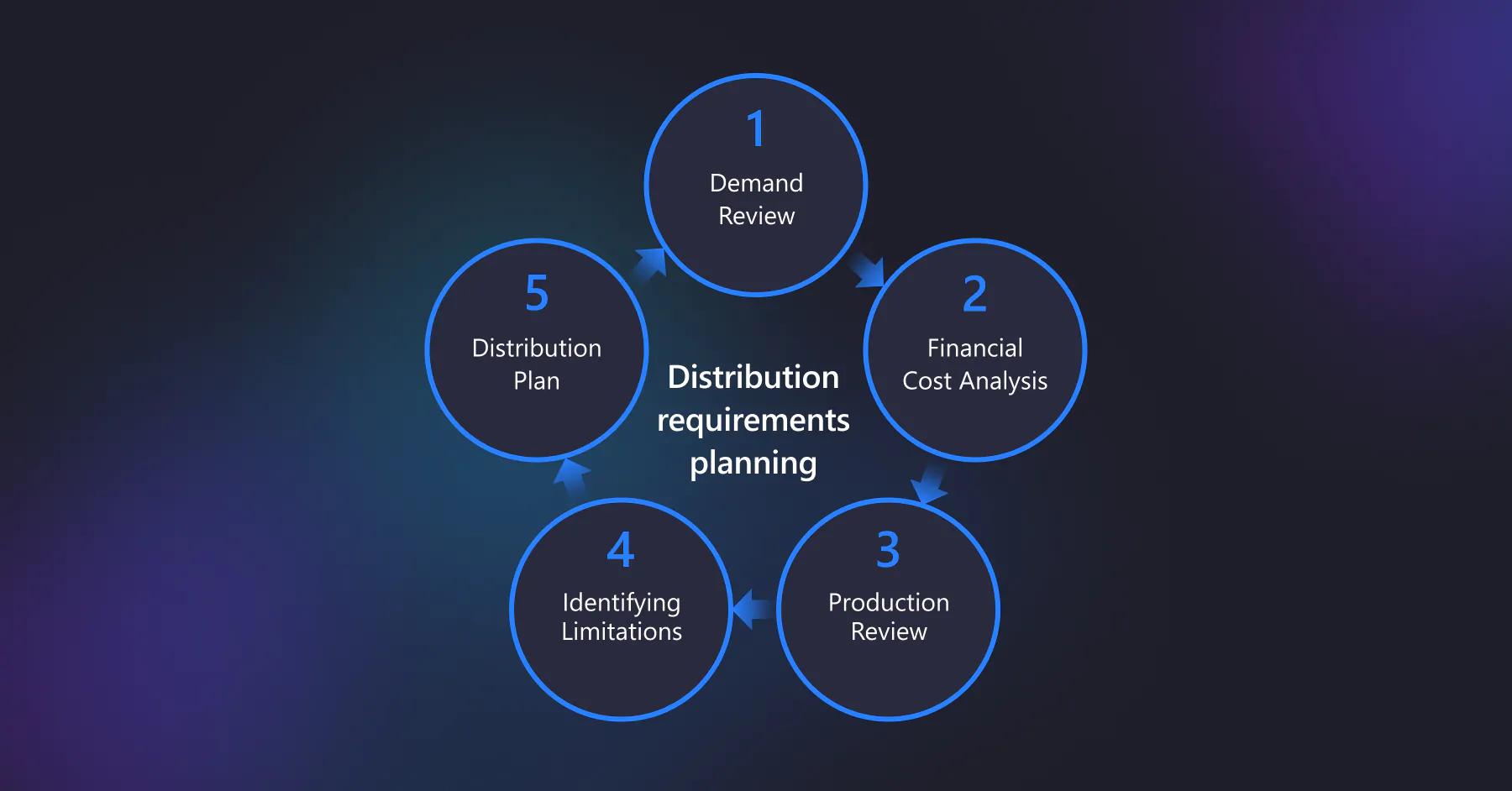
In the context of Supply Chain optimization, AI integration enhances DRP by predicting demand based on historical data analysis, automating production and logistics, optimizing delivery routes in real time, and reducing distribution costs. AI also improves risk management, allowing businesses to anticipate delays and ensure contract compliance.
Overview of the MRP Methodology
MRP (Material Requirements Planning) is a methodology that effectively coordinates material, raw material, and production capacity needs to ensure a continuous manufacturing process. It includes several key stages: demand analysis based on sales forecasts and orders, assessment of current inventory and identification of material shortages, and optimization of production schedules according to available resources. An essential aspect is also planning material supply while considering logistics costs and constraints related to transportation, warehouses, and production capacities.
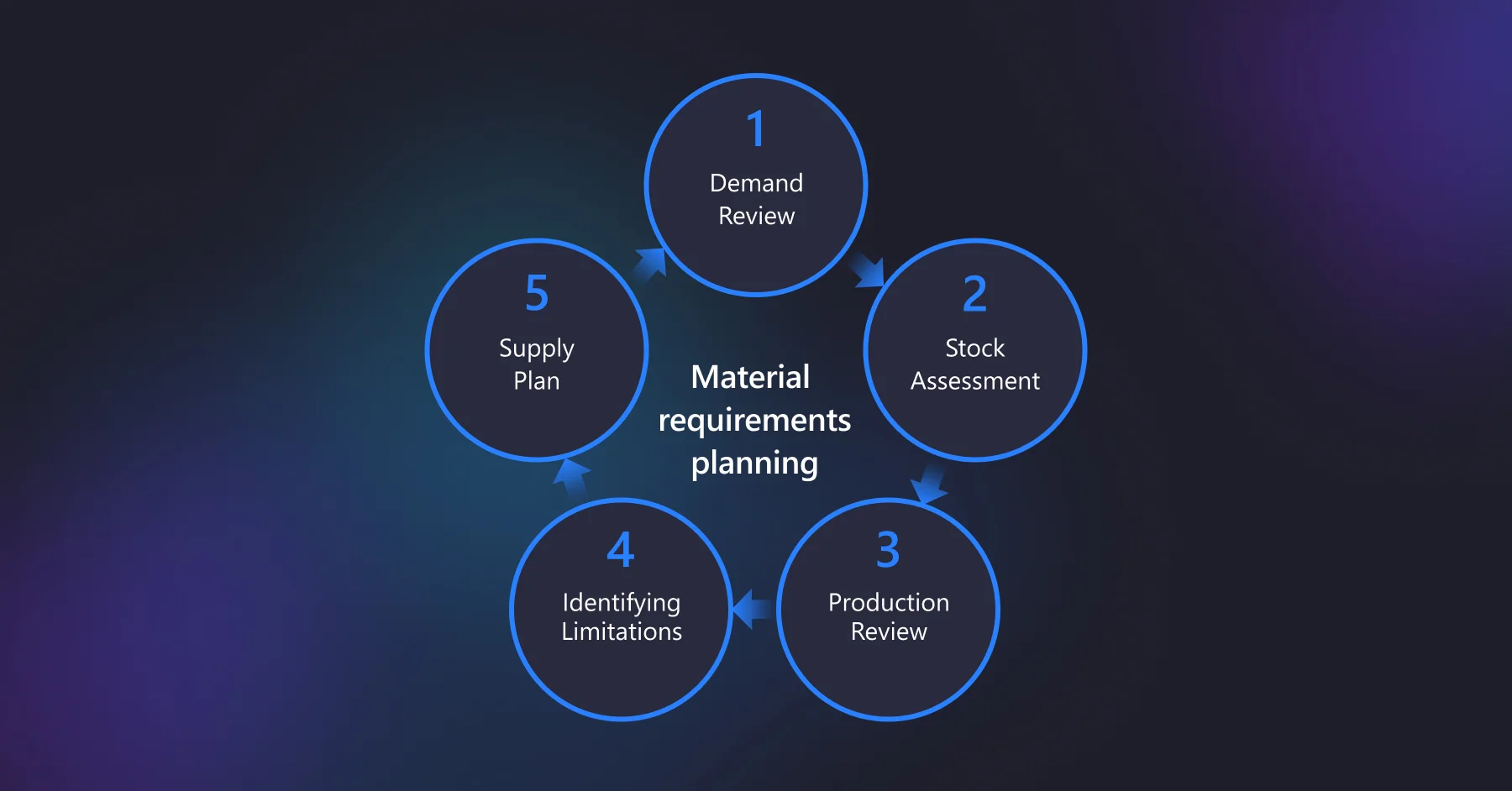
AI integration in MRP processes enables accurate demand forecasting for materials, automated distribution of production tasks, supplier and delivery route optimization, and real-time inventory monitoring. In the context of Supply Chain optimization, AI also helps identify and manage risks, anticipating potential supply delays and providing recommendations to minimize disruptions.
Overview of the DDMRP Methodology
DDMRP (Demand-Driven Material Requirements Planning) is a methodology focused on identifying and managing buffers within the supply chain to prevent shortages and delays in production processes. Its key feature is the detection of critical risk points, such as specific products, components, or suppliers where demand fluctuations or delays may occur. For each of these elements, minimum, target, and maximum inventory levels are set, regularly reviewed, and adjusted based on changes in demand, seasonality, or customer behavior.
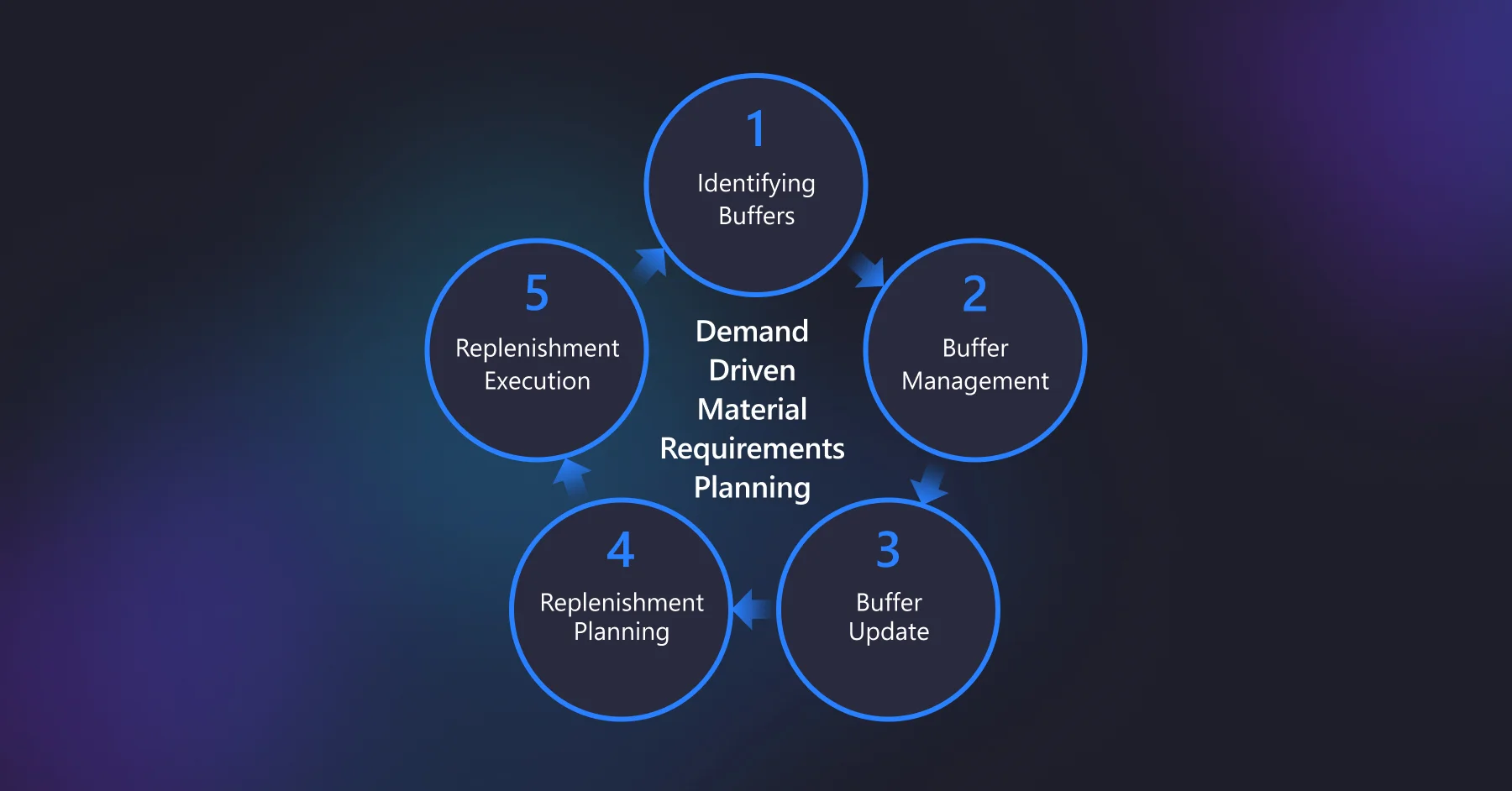
AI enhances DDMRP by improving supply chain management through data analysis and process automation. It helps forecast demand, identify critical risk points, optimize inventory buffers, and respond quickly to changes. AI can model dependencies between suppliers and customers, adjust delivery routes, predict delays, and automate replenishment planning. With AI, inventory management within the supply chain becomes more dynamic, flexible, and precise, minimizing shortages and optimizing storage costs.

The ideal scenario is when a business integrates all these methodologies comprehensively, as this approach ensures process alignment, reduces risks, and facilitates effective planning at all levels. At the strategic level, IBP defines business objectives, financial indicators, and long-term decisions. S&OP then balances medium-term forecasting, marketing strategies, and business constraints, while S&OE focuses on execution. DDMRP helps define buffers, clustering, and segmentation, whereas MRP and DRP handle operational execution, order management, and resource distribution. Tying all these processes together is demand forecasting, which serves as the key decision-making element at every level!
Seasonality, Anomalies, and Unpredictable Events: How the Use of Artificial Intelligence in Supply Chain Management Helps Businesses Adapt – Practical Tips for Managing Unexpected Situations
In Supply Chain Management, predictability is a luxury, while change is a daily reality. Sudden shifts in demand, unforeseen events, anomalies, and seasonal fluctuations force companies to find ways to adapt quickly. AI-powered demand forecasting provides a more accurate view of the future. Holiday sales, Black Friday, summer and winter discounts – these are traditional demand peaks in retail. AI-driven solutions, such as SMART Demand Forecast, help analyze historical sales data, track seasonal patterns, consider marketing activities, and even account for weather conditions to deliver the most precise forecasts. As a result, AI-based forecasting with, for example, Smart Demand Forecast enables retailers to achieve:
- Increase in demand forecasting accuracy by 20-30%,
- Reduction of stock levels after peak periods by 15-25%,
- Optimization of inventory and release of working capital from frozen stock.
Example of AI Usage in the Food Supply Chain for McDonald’s Georgia
The fast-food chain McDonald’s Georgia approached SMART business with a request to overcome the following challenges:
- Inaccurate forecasting at the individual restaurant level, leading to either shortages or surpluses.
- Increased operational costs due to the need for quick responses to demand.
- Excessive staff workload due to manual demand analysis.
After implementing the SMART Demand Forecast solution, the client achieved:
- An increase in sales forecast accuracy to 83.1% (based on 4-week data),
- A forecast deviation rate of up to 5%, which is considered the standard in the global business community,
- Better inventory management, avoiding losses.
The Role of AI in Supply Chain and Logistics for Timely Response to Anomalous Trends Related to Exceptional Events and Strategy Adjustments:
There are fluctuations that are difficult to predict using traditional methods, as they are often unconventional and depend on many external factors: pandemics, wars, logistics disruptions, closures during air raid alerts, anomalies, etc.
Anomalies are deviations from usual demand patterns, which can be caused by both positive and negative factors. For example:
- A sudden increase in demand due to a viral trend on social media (TikTok effect),
- A drop in sales due to geopolitical risks, economic crises, etc.
AI can account for anomalies in real-time by analyzing large volumes of data. Therefore, using AI in the Supply Chain helps companies adapt their purchasing, adjust marketing strategies, and streamline logistics processes.
Solutions that use AI algorithms, like SMART Demand Forecast, not only analyze internal data but also leverage external sources such as consumer behavior trends, economic indicators, and social media. This enables companies to not only respond to changes in a timely manner but also to forecast them in advance, flexibly adjusting their strategies. As a result, Supply Chain AI and demand forecasting ensures:
- Accounting for anomalous trends related to exceptional events.
- Using external sources to predict changes in demand and adapt the product range.
- Minimizing product shortages through more accurate supply planning.
- Reducing losses from excessive product discounts and decreasing write-offs.
- Increasing average sales by 15-20% due to optimal pricing and effective inventory management.
Example of AI Use in Demand Forecasting Within the Pharmaceutical Industry
For example, the pharmaceutical industry is particularly sensitive to various external factors: new flu strains, seasonal allergies, and increased demand for vitamins during cold spells. Without accurate forecasting, companies face either shortages or surpluses of products. The SMART Demand Forecast solution, which uses AI analysis, allows for forecasting the demand for medications based on historical data, seasonal factors, and even news indicators. As a result:
- Distributors can flexibly manage inventory,
- The risk of shortages and expired goods is reduced,
- Warehouse storage costs are cut.
Using AI in demand forecasting allows companies to stay ahead, minimizing risks, balancing supply and demand, and making supply chain management more resilient even during unstable periods.
Key Takeaways That Will Benefit Businesses and Help Understand the Role of AI in the Supply Chain
- There is no perfect universal approach – the demand forecasting strategy must be tailored to the specific business, operational scale, and level of uncertainty.
- AI does not replace people – it helps them make more accurate decisions. Analysts can focus on strategic tasks rather than routine calculations.
- Focus on forecast accuracy, as it directly impacts logistics, procurement, and the financial flows of the company.
- Work proactively, not reactively – use AI not just to respond to changes, but to predict them and build flexible strategies.
- Integrate AI into your Supply Chain and other key processes with SMART Demand Forecast – a comprehensive tool that helps companies stay one step ahead by adapting supply chains to the real challenges of the market.
Want to learn how artificial intelligence can enhance your strategy not only in Supply Chain but also in related business processes? Request a presentation, and the experts of SMART business will help uncover the full potential of the solution and find the best ways to strengthen your business.
